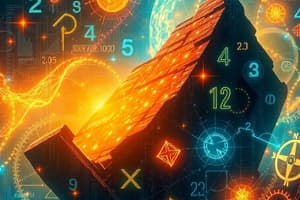Podcast
Questions and Answers
यदि किसी संख्या को 7 से गुणा किया जाता है और फिर परिणाम में से 5 घटाया जाता है तो परिणाम 32 है। उस संख्या का मान क्या है?
यदि किसी संख्या को 7 से गुणा किया जाता है और फिर परिणाम में से 5 घटाया जाता है तो परिणाम 32 है। उस संख्या का मान क्या है?
- 7
- 5
- 6
- 8 (correct)
निम्नलिखित में से कौन सा पूर्णांक है?
निम्नलिखित में से कौन सा पूर्णांक है?
- π
- √2
- 3/4
- -5 (correct)
1/2 और 3/4 के बीच कौन सी भिन्न आती है?
1/2 और 3/4 के बीच कौन सी भिन्न आती है?
- 7/8
- 1/3
- 5/8 (correct)
- 2/3
यदि 0.25 को प्रतिशत में बदल दिया जाए तो क्या परिणाम होगा?
यदि 0.25 को प्रतिशत में बदल दिया जाए तो क्या परिणाम होगा?
निम्नलिखित में से कौन सा समीकरण सही है?
निम्नलिखित में से कौन सा समीकरण सही है?
निम्नलिखित में से कौन सी संख्या प्राकृतिक संख्या नहीं है?
निम्नलिखित में से कौन सी संख्या प्राकृतिक संख्या नहीं है?
15/3 को सरल बनाने पर क्या परिणाम प्राप्त होता है?
15/3 को सरल बनाने पर क्या परिणाम प्राप्त होता है?
यदि किसी संख्या को 3 से विभाजित किया जाता है और फिर परिणाम में 7 जोड़ा जाता है तो परिणाम 19 है। उस संख्या का मान क्या है?
यदि किसी संख्या को 3 से विभाजित किया जाता है और फिर परिणाम में 7 जोड़ा जाता है तो परिणाम 19 है। उस संख्या का मान क्या है?
यदि $x + 5 = 12$ है, तो $x$ का मान क्या है?
यदि $x + 5 = 12$ है, तो $x$ का मान क्या है?
त्रिभुज के तीनों कोणों का योग कितना होता है?
त्रिभुज के तीनों कोणों का योग कितना होता है?
किसी आयत का क्षेत्रफल कैसे ज्ञात किया जाता है?
किसी आयत का क्षेत्रफल कैसे ज्ञात किया जाता है?
एक घन का आयतन कैसे ज्ञात किया जाता है?
एक घन का आयतन कैसे ज्ञात किया जाता है?
किसी डेटा सेट का माध्य क्या दर्शाता है?
किसी डेटा सेट का माध्य क्या दर्शाता है?
Flashcards
चर
चर
प्रतीक जैसे x, y, z जो अनजान मानों का प्रतिनिधित्व करते हैं।
समीकरण
समीकरण
दो अभिव्यक्तियों के बीच समानता दिखाने वाले वाक्य।
आकृतियाँ
आकृतियाँ
लाइन, कोण, त्रिभुज, चतुर्भुज, वृत्त जैसी बुनियादी आकृतियाँ।
मात्रात्मक डेटा
मात्रात्मक डेटा
Signup and view all the flashcards
आकर्षण
आकर्षण
Signup and view all the flashcards
जुड़ाव (Addition)
जुड़ाव (Addition)
Signup and view all the flashcards
घटाव (Subtraction)
घटाव (Subtraction)
Signup and view all the flashcards
गुणा (Multiplication)
गुणा (Multiplication)
Signup and view all the flashcards
भाग (Division)
भाग (Division)
Signup and view all the flashcards
क्रम (Order of Operations)
क्रम (Order of Operations)
Signup and view all the flashcards
अंश (Fraction)
अंश (Fraction)
Signup and view all the flashcards
दशमलव (Decimal)
दशमलव (Decimal)
Signup and view all the flashcards
प्रतिशत (Percentage)
प्रतिशत (Percentage)
Signup and view all the flashcards
Study Notes
Basic Arithmetic Operations
- Addition: Combining two or more numbers to find a total. Example: 2 + 3 = 5.
- Subtraction: Finding the difference between two numbers. Example: 5 - 2 = 3.
- Multiplication: Repeated addition of the same number. Example: 3 x 4 = 12 (which is 3+3+3+3).
- Division: Finding how many times one number is contained within another. Example: 12 ÷ 3 = 4.
- Order of Operations (PEMDAS/BODMAS): A set of rules for evaluating expressions with multiple operations. Parentheses/Brackets, Exponents/Orders, Multiplication and Division (left to right), Addition and Subtraction (left to right).
Number Systems
- Natural Numbers (Counting Numbers): 1, 2, 3, 4,... These are used for counting.
- Whole Numbers: 0, 1, 2, 3, 4,... These include zero and the natural numbers.
- Integers: ..., -3, -2, -1, 0, 1, 2, 3,... These include negative numbers, zero, and positive numbers.
- Rational Numbers: Numbers that can be expressed as a fraction p/q, where p and q are integers and q is not zero. Examples: 1/2, 3/4, -2/5.
- Irrational Numbers: Numbers that cannot be expressed as a fraction of two integers. Examples: √2, π.
- Real Numbers: The set of all rational and irrational numbers.
Fractions
- A fraction represents a part of a whole. It consists of a numerator (top number) and a denominator (bottom number).
- Equivalent Fractions: Fractions that represent the same value. Example: 1/2 = 2/4.
- Comparing Fractions: Determining which fraction is larger or smaller using common denominators or cross-multiplication.
- Adding and Subtracting Fractions: Requires finding a common denominator.
- Multiplying Fractions: Numerators are multiplied together, and denominators are multiplied together.
- Dividing Fractions: Invert the second fraction and then multiply.
Decimals
- A decimal represents a fraction with a denominator of 10, 100, 1000 and so on.
- Converting decimals to fractions and fractions to decimals.
- Arithmetic operations (addition, subtraction, multiplication and division) involving decimals.
Percentages
- A percentage represents a fraction or ratio out of 100.
- Converting percentages to decimals and vice versa.
- Applications of percentages: Calculating discounts, interest rates, and proportions.
Exponents and Powers
- Exponents represent repeated multiplication. For example, 23 = 2 x 2 x 2 = 8.
- Laws of exponents: Rules governing the manipulation of exponents. Examples include the product rule, quotient rule, and power rule.
Algebra
- Variables: Symbols (like x, y, z) that represent unknown values.
- Expressions: Combinations of variables and numbers using arithmetic operations.
- Equations: Statements that show equality between two expressions.
- Solving equations: Finding the value of the variable that makes the equation true.
- Inequalities: Showing that one quantity is greater than or less than another.
Geometry
- Basic shapes: Lines, angles, triangles, quadrilaterals, circles, etc.
- Properties of shapes: Angles, sides, area, and volume.
- Geometric formulas: Formulas for calculating areas and volumes of different shapes.
- Constructions of shapes using geometric tools.
Measurement
- Units of measurement: Standard units for length, mass, volume, time, etc.
- Converting between units of measurement.
- Using measurement tools to obtain precise measurements.
Data Handling
- Collecting, organizing, and representing data.
- Types of data: Qualitative and quantitative data.
- Data displays: Charts, tables, graphs.
- Measures of central tendency: Mean, median, mode.
- Measures of spread: Range, variance, standard deviation.
Studying That Suits You
Use AI to generate personalized quizzes and flashcards to suit your learning preferences.




